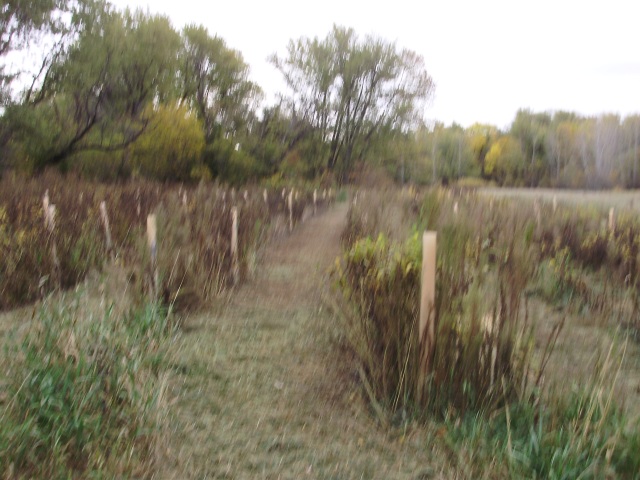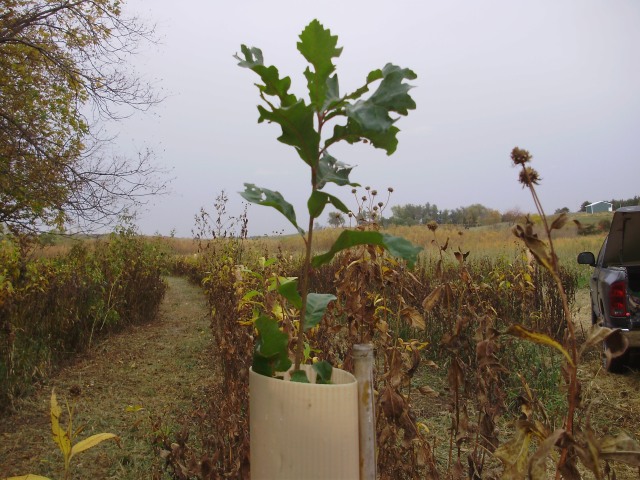On our vacation in October we went to the farm to check on the trees and the tree tubes and to see how the trees fared during this years drought. The tree tubes have worked great so far but are not perfect. In this post I want to talk about the advantages and disadvantages of using tree tubes.
In the fall of 2010 we planted over 1200 fruit and nut trees on our property as a repairin buffer along the creek on the north side of our property as part of the contract we have with the Farm Service Agency. We put 300 tree tubes over part of the 1200 trees. I did a post about it Planting of the Trees, it was the second planting that was done on this property, the first attempt at planting trees failed by the previous owner because of the many deer eating the small seedlings over the first winter and flooding on the property. Also they never mowed around the trees and the tall Canary grass robbed the little trees of sun light, water and nutrients and living in the tall grass were lots of field mice and vols that also like to dine on small trees girdling the trees in the winter when food is scarce. After the first year not one of the small trees could be found.
I had to find a solution to protect the trees from the many dangers until they got big enough to get established and that solution was tree tubes. In the post I did about The Flooding Aftermath I talked about a lot of the advantages of using tree tubes and I am sure all of the trees we had planted this time would have been lost without them, but they are not perfect and do have some disadvantages that the manufactures and the people who sell them don’t tell you about. I will tell you from my experience what I recommend you do and what to use if you decide to use tree tubes.

With tree tubes you can see how your rows run so you don’t mow over trees that are not in the tubes.
One of the big disadvantages is the initial cost. The tube, stake, weed mat, landscape staples for holding the weed mat in place and the plastic zip ties that hold the tube to the stake cost about 5.00 per tree. If you are doing just a few the cost is not bad but if you do 300 like we did, it gets to be expensive. If you have an area where there are lots of deer and tall grass and weeds, I strongly recommend using tree tubes and not waste your money on anything shorter than the 5 ft tube. The 5ft tube helps to protect the tree as it emerges out of the top of the tube from deer, tree tubes may keep you from having to replant.
Use 1/2 inch pvc pipe for stakes
I recommend if you decided to use tree tubes do not use bamboo or oak stakes for your tube. I used bamboo because they were the cheapest and I tried to save a little money. This mistake has ended up costing me more money and time, because now after only two years of being in the field my bamboo stakes are starting to rot. I plan to replace them all this coming spring using 1/2 inch pvc stakes. The thicker walled pvc pipe will never rot and is supposed to stimulate stem growth from the pvc pipe swaying with the wind like the tree would do. You can buy a ten foot length of thicker walled pvc for about 1.20 each at Homedepot. Then cut it into 2 5ft sections. You will have a stake for .60 cents apiece that will last the life time of the tube and can be reused or recycled.
One of the biggest disadvantages that people who sell tree tubes don’t tell you about is that wasp like to make nest in the tubes. Now wasp in themselves do not harm the tree or the tree tube, but raccoons love to eat wasp larvae that are in the nest. They make a nice little protein snack and raccoons eat them like candy. The nest is usually towards the top of the tube and the raccoon climbs the tube until it crumples like in the picture below. They then shred the tube to get to the nest and in the process destroys the tube and sometimes kill the tree.
Believe it or not, most of the trees that were in theses tubes were still alive when we found them. We had about 15 tubes destroyed by raccoons and I am sure there would have been more destroyed but when we were there in June I saw that the wasps were starting to build their nest in the tubes and I got rid of them. If you can get to the nest before it gets big and have lots of wasp on them is the time to do it. What I did was look into the top of the tube and if I saw a nest starting to form I would crush the nest by smashing my two hands together on the out side of the tube where the nest was. With only one or two wasp on the nest there was not much of chance getting stung.
This tree in the picture above was in the tube that was destroyed by a raccoon. It was broken and luckily it had another stem coming off it towards the bottom, so we cut the broken stem off and put a wire cage around it that is 5ft tall. This is an experiment, it does not protect it against mice and vols so we will see how this works. I also used this same set up for some of the trees that we had not originally not put in tubes.
There you have some of the disadvantages of using tree, but I think the advantages far out way the disadvantages. I recommend using tubes even if you are just planting one tree in your yard or starting a 300 tree grove, they protect your young tree until they get big enough to survive. That way all your time and money isn’t wasted.



